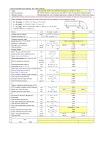As we know there are various connecting types for the pipe fittings: Socket weld, Butt weld, Threaded, and flanges.Two of them to be quite popular :- Socket Weld and Butt Weld .
In these article we will discus about the Socket Weld Connection. 
Socket Weld fittings are mainly used for small pipe diameters (Small Bore Piping); generally for piping whose nominal diameter is NPS 2 or smaller. Socket Welded Joints construction is a good choice wherever the benefits of high leakage integrity and great structural strength are important design considerations.
How Socket Welding Works
Socket welding is named for the fittings into which the pipes are placed for welding. These fittings include recessed sockets into which the pipes are inserted before being welded into place.
When inserting the pipe into the socket it is important to leave a gap between the end of the pipe and the bottom of the socket. This gap prevents a stress failure from occurring when the heat from the welding process causes the pipes to expand against the socket. This gap can be manually measured and marked with a reference line on the pipe, or a permanent fitment tool can be inserted into the fitting to ensure the pipe does not bottom out into the socket. Once placed in position, the pipe is fixed in place by fillet welding where the pipe diameter meets the socket.
Socket welds create sealed, leak-proof, high pressure pipeline configurations for the transporting of liquids or gases. Unlike butt welding, socket welds don’t require any pre-weld machining, although the pipe ends should be clean in order to assure the integrity of the weld.
Some details of Socket Weld fittings
- SW Fittings are family of high pressure fittings are used in various industrial processes. They are used for lines conveying flammable, toxic or expensive material where no leakage can be permitted, and for steam 300 to 600 PSI.
- They are used only in conjunction with ASME Pipe and are available in the same size range.
- They are used in areas where pipe-work is permanent and are designed to provide good flow characteristics.
- They are are produced to several ASTM standards and are manufactured in accordance with ASME B16.11. The B16.11 standard covers pressure-temperature ratings, dimensions, tolerances, marking, and material requirements for forged carbon and alloy steel. Acceptable material forms are forgings, bars, seamless pipe, and seamless tubes which conform to the fittings chemical requirements, melting practices, and mechanical property requirements of ASTM A105, A182, or A350.
- They are available in three pressure ratings.. Class 3000, 6000 and 9000.
Types of Socket Weld Fittings by Class, Size and Wall Thickness


Different kinds of Socket Weld Fittings
Here is everything you need to know about different types of socket weld fittings.
Full Coupling
 |
| This connection joins two pipes together. Full couplings have threads at both ends to connect both pipes. |
Half Coupling
Reducing Coupling

This pipe fitting connects two pipes of different diameters. The
reducing coupling has different widths on both ends so that the pipes of
different diameters can be connected.
Socket Weld Union
Socket Weld Elbow
Socket Weld Tee
Sockolet
Socket Weld Cross
 |
| This connection enables a 90-degree direction change for branches connected between 2 pipes going in the same direction. |
Socket Weld Cap

As the name suggests, the socket weld cap is connected to the end of a pipe to seal it.
Socket Weld Flanges
Socket Welding Advantages
- The pipe is need to be beveled for preparation of weld
- Temporary tack welding generally no need be required for alignment. This is because the principle in fitting would help to make sure that alignment be proper.
- The socket weld metal is not be able to penetrate the bore of the pipe
- Costs of construction have been found to be lower than butt-welded joints. Due to elimination of special machines and the lack of exact fit-up requirements.
Socket Welding Disadvantages
- The welder should make sure that the expansion gap between the shoulder of the socket and the pipe should be 1.6mm
- The internal crevices and expansion gap in socket weld systems would promote corrosion. It would be because of this reason that they have been deemed to be less suitable for radioactive or corrosive applications
- These kinds of fittings would also be unacceptable for Ultra High Hydro static Pressure in food industries. This is because in addition to not allowing full penetration, it would also leave crevices and gaps that would then become very difficult to clean.


















0 Comments